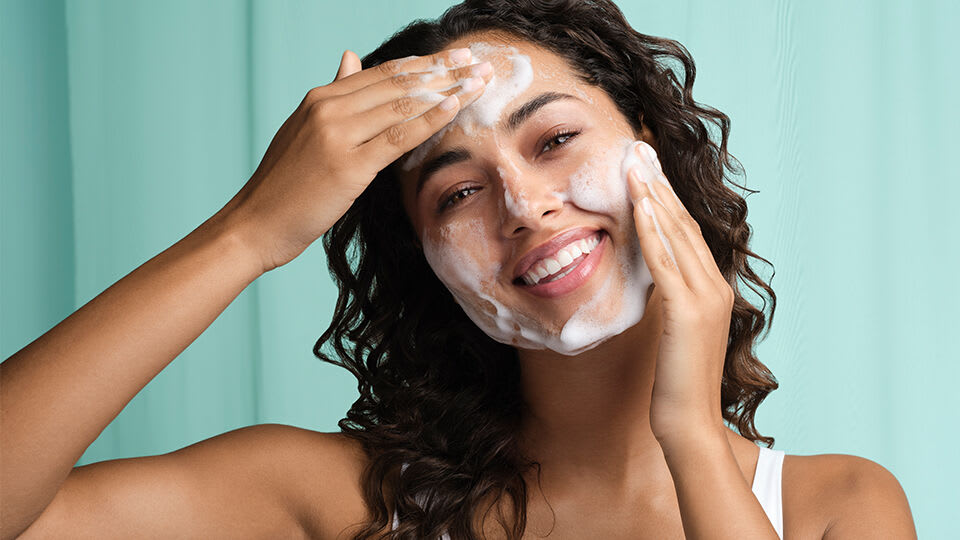Oily skin is often maligned, but there are a handful of benefits with additional oil production. The trick to managing oiliness is utilizing a skincare routine specifically optimized for oily skin. This guide explores the most effective oily skincare routine for more balanced skin.

Oily skin is one of the most common skin types, yet the emotional and social impact of having oil-prone skin can be debilitating. One study found that participants with oily skin reported feelings of “unattractiveness, self-consciousness, embarrassment, irritation, and frustration.” Additional research has shown that those with oily skin can feel “uncomfortable or unkempt and annoyed” by the skin type. As devastating as that is, having oily skin is perfectly normal and perhaps even beneficial—some experts believe the excess oil and sebum lubricate the skin, allowing the face to age with less visible fine lines and wrinkles (although more research needs to be completed to solidify this belief). That said, oily skin unmanaged with an effective regime can exacerbate excess oil, potentially leading to clogged pores. Looking for tips to curb the skin’s natural oil production? When we support the skin’s natural processes through cleansing, exfoliation, and hydration, a reduction in congestion, breakouts, and hyperpigmentation can naturally occur. Keep reading to understand more about excessive oil consumption and the most effective skincare routine for oily skin.
Oily Skin Explained
According to the American Academy of Dermatology, oily skin is one of the five skin types (with the others being sensitive, normal, dry, and combination skin). What causes oily skin in the first place? It’s often due to genetics, so you can thank your parents for your naturally supple skin. It can also be caused by heightened hormone levels. What’s happening under the skin is sebaceous glands are secreting sebum, which naturally lubricates the skin, protecting it from drying out. But sometimes sebaceous glands can produce excess sebum, causing the skin to look excessively shiny or pores to become clogged.
Skincare Routine For Oily Skin
If you have oily skin or an oily T-zone area, your skin produces extra sebum that can lead to clogged pores and potentially breakouts. Utilizing the following oily skincare routine helps bring harmony back to the skin with just a few simple steps.
Step One: Cleanse
The first, and perhaps most important, step in your ritual is to purify your complexion with a facial cleanser. From starting the morning fresh to unburdening the skin at the end of the day, cleansing helps wash away impurities, dirt, and other buildup accumulated throughout the day and night. Whether it's indulging in a double cleanse or an exfoliating cleanser, the right face wash can minimize excess oil, unclog and minimize the appearance of pores, and leave skin soft and ready for the next steps in your oily skincare routine.
Step Two: Exfoliate
After cleansing, oily skin will love exfoliation. Why? Exfoliating can make pores less noticeable, says the AAD. This is because when pores are clogged, they look more noticeable, and effective exfoliation basically ‘cleans out’ pores, helping to eliminate excess oil, sebum, and dead skin cells while visibly tightening the appearance of pores. This can be accomplished with physical exfoliation (scrubs or washcloths) or liquid exfoliating treatments (formulas with AHAs and/or BHAs). Check the product’s packaging to get the recommended usage tips, as some exfoliants are designed to be used nightly or twice a day (or only a few times a week).
Step Three: Treat
Serums are a great follow-up step after exfoliation, as they’ll be able to absorb beautifully. Serums are highly potent skincare solutions that work to increase the overall effectiveness of a skincare ritual. They tend to zero in on one focus, like brightening, hydrating, or clarifying pores. Some serums can even multitask, targeting multiple concerns at once, like brightening and exfoliating. Consider what you’d like a serum to help you accomplish and seek out one with proven ingredients and clinical results.
Step Four: Moisturize
You might be tempted to forgo a moisturizer completely due to excessive oiliness, but skipping a face lotion can backfire, causing the skin to produce even more sebum to make up for the dryness—after all, even oily skin can quickly become dehydrated. That said, an effective moisturizer is one of the most difficult products to discover for oily skin. A moisturizer is not a one-size-fits-all product, notes the AAD. They note that a moisturizer can come in several different formats, including lotions, gels, thick creams, or ointments. For oily skin, consider a lightweight, clarifying moisturizer for morning and night usage, right after a serum (or cleansing, if you’re skipping a serum).
Step Five: Protect
Sunscreen often has the reputation of thick, pore-clogging formulas, so much so that you might be tempted to skip SPF altogether to spare your oily skin–but don’t. Modern sunscreen iterations are brilliantly lightweight and soothing. Some can even include pore-refining ingredients, like niacinamide, that have the ability to minimize the size of pores, reduce redness, and even skin tone. Ensure that you follow the FDA guidelines on how to apply sunscreen and what to look for in SPF packaging.
For a deep dive into the best products for oily skin, we’ve compiled an extensive guide here, analyzing every product that can help oily skin become more balanced and soothed. As always, if you’d like help customizing your daily ritual for your specific skin, consult our Ritual Finder.

